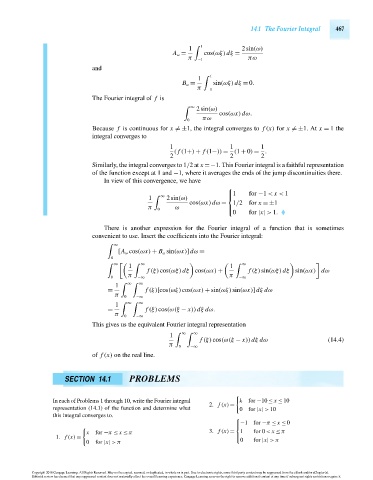Page 487 - Advanced engineering mathematics
P. 487
14.1 The Fourier Integral 467
1 1 2sin(ω)
A ω = cos(ωξ)dξ =
π −1 πω
and
1 1
B ω = sin(ωξ)dξ = 0.
π −1
The Fourier integral of f is
∞
2sin(ω)
cos(ωx)dω.
πω
0
Because f is continuous for x =±1, the integral converges to f (x) for x =±1. At x = 1the
integral converges to
1 1 1
( f (1+) + f (1−)) = (1 + 0) = .
2 2 2
Similarly, the integral converges to 1/2at x =−1. This Fourier integral is a faithful representation
of the function except at 1 and −1, where it averages the ends of the jump discontinuities there.
In view of this convergence, we have
⎧
⎪1 for −1 < x < 1
1 ∞ 2sin(ω) ⎨
cos(ωx)dω = 1/2 for x =±1
π 0 ω ⎪
0 for |x| > 1.
⎩
There is another expression for the Fourier integral of a function that is sometimes
convenient to use. Insert the coefficients into the Fourier integral:
∞
[A ω cos(ωx) + B ω sin(ωx)]dω =
0
∞ ∞ ∞
1 1
f (ξ)cos(ωξ)dξ cos(ωx) + f (ξ)sin(ωξ)dξ sin(ωx) dω
π π
0 −∞ −∞
1 ∞ ∞
= f (ξ)[cos(ωξ)cos(ωx) + sin(ωξ)sin(ωx)]dξ dω
π 0 −∞
1 ∞ ∞
= f (ξ)cos(ω(ξ − x))dξ dω.
π 0 −∞
This gives us the equivalent Fourier integral representation
1 ∞ ∞
f (ξ)cos(ω(ξ − x))dξ dω (14.4)
π 0 −∞
of f (x) on the real line.
SECTION 14.1 PROBLEMS
In each of Problems 1 through 10, write the Fourier integral k for −10 ≤ x ≤ 10
2. f (x) =
representation (14.1) of the function and determine what 0 for |x| > 10
this integral converges to.
⎧
⎪−1for −π ≤ x ≤ 0
⎨
x for −π ≤ x ≤ π 3. f (x) = 1 for 0 < x ≤ π
1. f (x) = ⎪
⎩
0 for |x| >π 0 for |x| >π
Copyright 2010 Cengage Learning. All Rights Reserved. May not be copied, scanned, or duplicated, in whole or in part. Due to electronic rights, some third party content may be suppressed from the eBook and/or eChapter(s).
Editorial review has deemed that any suppressed content does not materially affect the overall learning experience. Cengage Learning reserves the right to remove additional content at any time if subsequent rights restrictions require it.
October 14, 2010 16:43 THM/NEIL Page-467 27410_14_ch14_p465-504

